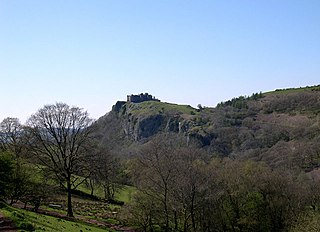
Llangathen is a village and community located in Carmarthenshire, Wales. The population taken at the 2011 census was 507.
Allt Penycoed Stream Section is a Site of Special Scientific Interest in Carmarthenshire, Wales. It is protected by law and has been designated as an SSSI since April 1985 in an attempt to protect rare or unique features or species within it. The site has an area of 1.62 hectares and is managed by Natural Resources Wales.

Allt y Gaer is a Site of Special Scientific Interest (SSSI) in Llangathen community, Carmarthenshire, Wales. It is a 3.5ha conifer woodland on the northern slopes of the Tywi Valley, which has SSSI protected designation because it holds the largest heronry in West Wales.

Beacon Bog is a Site of Special Scientific Interest in the community of Llangynog in Carmarthenshire, Wales.

Carreg Cennan is a Site of Special Scientific Interest (SSSI) in Carmarthenshire, Wales. The site consists of a 19.5-hectare (48-acre) strip of land surrounding a line of carboniferous limestone cliffs.
Croes Robert Wood is a nature reserve and Site of Special Scientific Interest (SSSI), noted for its biological characteristics, in Monmouthshire, south east Wales. Gwent Wildlife Trust, the owners of the site, manage the woodland through methods of coppicing and charcoal burning to encourage its notable flora and fauna.

Upper Wye Gorge is a Site of Special Scientific Interest (SSSI), noted for its biological and geological characteristics, around Symonds Yat in the Wye Valley on the Wales–England border. The site is listed in the 'Forest of Dean Local Plan Review' as a Key Wildlife Site (KWS).

Bull Cross, The Frith and Juniper Hill is a 42.33-hectare (104.6-acre) biological and geological Site of Special Scientific Interest in Gloucestershire, notified in 1954. The site is listed in the ‘Stroud District’ Local Plan, adopted November 2005, Appendix 6 as an SSSI and Regionally Important Geological Site (RIGS).

The Hudnalls is a 94.4-hectare (233-acre) biological Site of Special Scientific Interest in Gloucestershire, notified in 1972. The site is listed in the 'Forest of Dean Local Plan Review' as a Key Wildlife Site (KWS).
Allt Pontfaen - Coed Gelli-fawr is a Site of Special Scientific Interest in Pembrokeshire, South Wales which starts at Allt Pontfaen and finishes at Coed Gelli-fawr. It has been designated as a Site of Special Scientific Interest since January 1954 in an attempt to protect its fragile biological elements. The site has an area of 73.12 hectares and is managed by Natural Resources Wales.

Gallt Llanerch - Coed Gelli-deg is a Site of Special Scientific Interest in the Gwaun Valley, Pembrokeshire, South Wales. It has been designated as a Site of Special Scientific Interest since January 1954 in an attempt to protect its fragile biological elements. The site has an area of 30.47 hectares and is managed by Natural Resources Wales.
Hook Wood is a Site of Special Scientific Interest in Pembrokeshire, South Wales. In 1603 George Owen described Hook Wood as one of “the best standing woods” of Pembrokeshire. It has been designated as a Site of Special Scientific Interest since January 1986 in an attempt to protect its fragile biological elements. The site has an area of 12.02 hectares and is managed by Natural Resources Wales. SSSIs in Wales have been notified of a total of 142 different animal species and 191 different plant species.
Wyndrush Pastures is a Site of Special Scientific Interest south-east of the village of Redberth, just south of the A477, and around five km (3.1 mi) to the north-west of the coastal town of Tenby in Pembrokeshire, South Wales. It has been designated as a Site of Special Scientific Interest since October 1999 in an attempt to protect its fragile biological elements. The site has an area of 45.5 hectares and is managed by Natural Resources Wales.

Hanger Wood is an ancient woodland and Site of Special Scientific Interest (SSSI) in the parish of Stagsden, Bedfordshire in the United Kingdom. Situated approximately one kilometre east of the village of Stagsden, the 24.12 hectares woodland was declared a SSSI in 1988, being described by Natural England as "one of the best remaining examples of wet ash-maple woodland in Bedfordshire". The name "Hanger" comes from Old English/Anglo-Saxon term for "wood on a hill" or "wooded hill", applied to Hanger Wood due to its situation on a northwest-facing slope of a narrow ridge. Commenting on the wood's character, A. Simco said in 1984 that "It has been strongly influenced by the geology and topography of the area, particularly by the south-west/north-east boulder clay ridge along which the parish boundary runs."

Odell Great Wood is an ancient woodland and biological Site of Special Scientific Interest (SSSI) in Odell in Bedfordshire. Located around the centre of the parish of Odell, the site was described by Natural England as "in many respects the best example in Bedfordshire" of wet ash-maple woodland, and in historical sources as "the noblest wood in this county". Being one of the largest of Bedfordshire's ancient woodlands, the wood hosts a wide variety of flora and fauna in its ash, oak and hazel coppice habitat.
Gweunydd Glan-y-glasnant is a Site of Special Scientific Interest (SSSI) in Carmarthenshire, Wales, designated in 1993 for its botanical features.
Nance Wood is a woodland Site of Special Scientific Interest (SSSI) near Portreath, west Cornwall. The site was first notified in 1951 for its almost pure dwarf, sessile oak coppiced woodland, good bryophyte flora and Irish spurge, which is found in only two localities in Britain.










